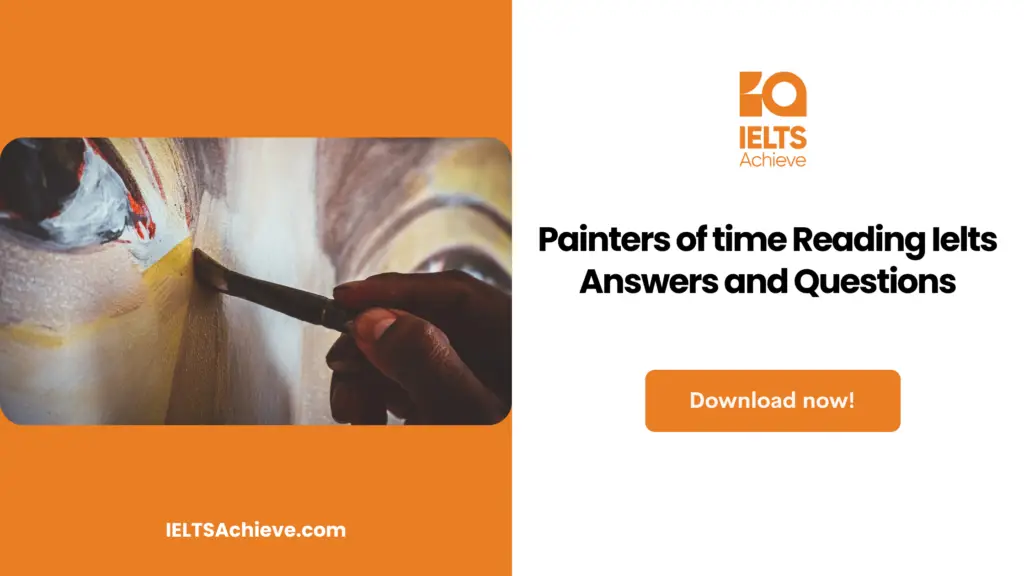The Blog post contains the following IELTS Reading Questions:
- IELTS Reading Flowchart Completion
- IELTS Reading Multiple Choice Question
- IELTS Reading Matching headings
Stay informed and prepared for success – Explore our comprehensive Reading Test Info page to get valuable insights, exam format details, and expert tips for mastering the IELTS Reading section.
IELTS Reading Passage – Painters of time

Painters of time
The works of Aboriginal artists are currently in high demand across the globe, not only in Australia, where they are already well-known: the National Museum of Australia, which opened in 2001 in Canberra, dedicates 40 percent of its exhibition space to works by Aborigines. Their artwork is on display at a museum in Lyon, Europe. France, and the upcoming Quai Branly museum in Paris – This is going to concentrate on the arts and traditions of Africa. Oceania, Asia, and the Americas – wants to commission frescoes from Australian artists.
Their artistic movement started around thirty years ago. However, its beginnings date back to the dawn of time. All of the works reference “the Dreaming,” the foundation story of Aboriginal culture. This interior geography, depicted with a brush and shades, is also a reflection of the Aborigines’ long work to recover the land that Europeans took from them in the nineteenth century. One such artist replied, “Painting is worthless without history.” Michael Nelson Tjakamarra.
Less than 400,000 Aborigines now reside in Australia. They have been overwhelmed by the nation’s 17.4 million immigrants. These original ‘natives’ had lived in Australia for 50,000 years, yet they were certainly abused by those who came. The Aborigines were subjected to a policy of ‘assimilation,’ which included the kidnapping of children to make them better ‘integrated’ into European culture and the forcible herding of the nomadic Aborigines into settled communities or relocating to the most empty lands.
It was at one of these communities, Papunya, in the middle desert, near Alice Springs, that Aboriginal art first came into its own. In the year 1971, a white educator. Geoffrey Bardon recommended to a group of Aborigines that they decorate the school walls with symbols of rituals. In order to transmit to the younger generation the myths that were starting to vanish from their collective memory, they provided them with paintbrushes, colours, and cardboard and canvas surfaces on which to paint. He was stunned at the result. But their art did not come out of thin air: for thousands of years, Aborigines had been “painting” with coloured sands on the ground and on rock barriers. Additionally, they had painted their bodies for ceremonial reasons. So there existed a formal vocabulary.
Europeans had already noticed this reality. Early in the twentieth century. Aboriginal groups drawn together by missionaries in northern Australia were encouraged to imitate designs noticed on rock faces on tree bark. Aboriginal paintings started to reach abroad museums between 1950 and 1996, when artists developed a constant supply of works with the help of the churches, which helped in their public distribution. In the north, bark painting survived, although groups in the central desert increasingly used acrylic paint. Elsewhere in Western Australia, women looked into the possibility of wax painting and ‘batik’ dyeing methods.
What Aborigines define are always elements of the Dreaming, the communal past of which each group is both a part and an ambassador. I Dreaming is the story of their beginnings, of their “Great Ancestors,” who transmitted their knowledge, art and abilities (such as hunting, medicine, painting, music, and dancing) to mankind. The moment the world was formed is not synonymous with dreaming. according to Stephane Jacob, one of the Lyon exhibition’s organisers. ‘That moment has never ceased to exist for Aborigines. It is maintained through the Aborigines’ organisation of religious rites and the cycle of the seasons. Actually, the purpose of these ceremonies is also to preserve the endurance of the golden era. Even in its present expressions, the primary purpose of Aboriginal art is to guarantee the survival of the planet. The Dreaming includes both the past and the future.’
Each work is produced separately, with a form that is distinctive to its creator, yet it is created for and on behalf of a community that has to approve it. An artist cannot use a ‘dream’ that does not belong to his/her society, since each community is the owner of its dreams, just as it is connected to an area defined by earlier ones. Therefore, every image may be viewed as a spiritual path map for that community.
Nowadays, each community is organised as a cooperative and utilises the services of a cultural advisor, a government-employed agent who provides the artists with materials, is negotiating with galleries and museums, and redistributes earnings from sales among the artists.Today, Aboriginal art is a huge success. In Australia, some works sell over $25,000, while exceptional pieces can fetch up to $180,000.
‘By exporting their paintings as if they were national surfaces, and by accompanying them to the temples of western art.’ According to Yves Le Fur. of the Quai Branly museum, the Aborigines have reconstructed the geography of their homeland, from which they were dark. There have been works of art created. Their evident power encourages a discourse that has been all too seldom in the history of relations between both cultures.’
Unlock your full potential in the IELTS Reading section – Visit our IELTS Reading Practice Question Answer page now!
Recommended Questions:
Renewable Energy IELTS Reading Question with Answer
Painters of time IELTS Reading Questions
Questions 1-4
Complete the flowchart below.
Choose No More Than Three Words from the passage for each answer.
- For __________, Aborigines produced ground and rock paintings.
- In the early 20th century, churches first encouraged the use of __________ for paintings.
- Mid-Twentieth century, Aboriginal paintings were seen in _______________.
- In the early 1970s, Aboriginal painted traditional patterns on ______________ in one community.
Boost your performance in Summary, Notes, Table, and Flowchart Completion tasks. Click here to explore our detailed guide and learn how to effectively complete summaries, notes, tables, and flowcharts in the IELTS Reading section.
Questions 5-7
Choose the correct letter, A, B, C or D. Circle the correct letter in
5. In Paragraph G, the writer suggests that an important feature of aboriginal art is
- Its historical context
- Its significance to the group
- Its religious content
- Its message about the environment
6. According to Aboriginal beliefs, there is a significant relationship between
- Communities and lifestyles
- Images and techniques
- Culture and form
- Ancestors and territory
7. In Paragraph I, the writer suggests that Aboriginal art invites Westerners to engage with
- The Australian land
- Their own art
- Aboriginal culture
- Their own history
Ready to improve your performance in Multiple Choice Questions (MCQs)? Click here to access our comprehensive guide on how to tackle MCQs effectively in the IELTS Reading section.
Questions 8-13
Reading Passage has seven paragraphs, A–H.
Choose the correct heading for each paragraph from the list of headings below. Write the correct number, i–viii, in your answer sheet.
Amazing results from a project
- New religious ceremonies
- Community art centres
- Early painting techniques and marketing systems
- Mythology and history combined
- The increasing acclaim for Aboriginal art
- Belief in continuity
- Oppression of a minority people
8. Paragraph A
9. Paragraph B
10. Paragraph C
11. Paragraph D
12. Paragraph E
13. Paragraph F
Ready to conquer Matching Headings questions? Click here to learn essential tips and techniques for matching headings accurately to paragraphs or sections in the IELTS Reading section.
Unlock your full potential in the IELTS Reading section – Visit our IELTS Reading Practice Question Answer page now!
Recommended Questions:
Renewable Energy IELTS Reading Question with Answer
Painters of time reading answers
1. thousands of years
2. (tree) bark
3. abroad museums
4. school walls
5. B
6. D
7. C
8. vi
9. v
10. viii
11. i
12. iv
13. vii

We hope you found this post useful in helping you to study for the IELTS Test. If you have any questions please let us know in the comments below or on the Facebook page.
The best way to keep up to date with posts like this is to like us on Facebook, then follow us on Instagram and Pinterest. If you need help preparing for the IELTS Test, join the IELTS Achieve Academy and see how we can assist you to achieve your desired band score. We offer an essay correction service, mock exams and online courses.

